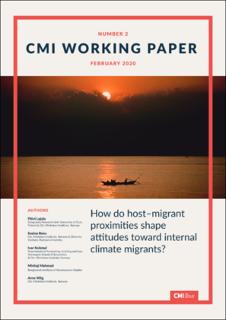How do host–migrant proximities shape attitudes toward internal climate migrants?
Working paper
Permanent lenke
https://hdl.handle.net/11250/2649524Utgivelsesdato
2020-02-01Metadata
Vis full innførselSamlinger
- Publications [1488]
Originalversjon
Bergen: Chr. Michelsen Institute (CMI Working Paper WP 2020:2)Sammendrag
Countries in Latin America, Asia, and Africa exposed to the environmental consequences of climate change are predicted to see voluntary and forced internal migration on an unprecedented scale in the coming decades. This will likely put a great strain on host communities receiving the internally displaced. In many communities, the long-term residents may be skeptical toward the internal climate migrants, creating grounds for heightened tensions and even violent conflict. To alleviate such tensions, it is important to understand how attitudes toward internal climate migrants among host community members form, an issue that has thus far received little attention in climate research. To promote research on host communities receiving internal climate migrants in developing countries, this article develops a conceptual framework which seeks to map key factors influencing attitudes toward climate migrants. It proposes that distance between migrants and host community members along multiple dimensions is central to understanding how such attitudes form. The framework categorizes the different dimensions of distance into spatial, attitudinal, experiential, and social proximity. The article applies the framework to a survey conducted among over 630 long-term host community residents in the climate exposed Satkhira District of Bangladesh and finds evidence that variables reflecting these categories of proximity shape attitudes toward internal climate migrants. Highlights
Host–migrant proximities shape attitudes toward internal climate migrants Attitudes toward internal climate migrants are inherently relational Attitudes toward climate migrants worsen with increased spatial and social distance Values and worldviews influence perceptions about internal climate migrants
Utgiver
Chr. Michelsen InstituteSerie
CMI Working Paper WP 2020:2CMI Working Paper WP 2020:2
CMI Working Paper WP 2020:2
CMI Working Paper WP 2020:2
